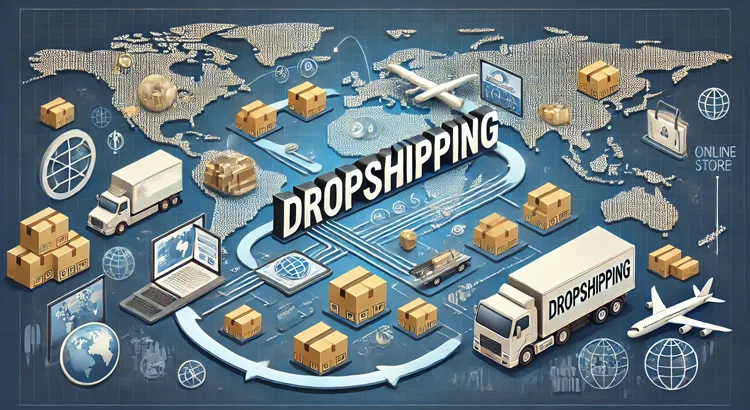Dropshipping in India allows you to sell products online without holding inventory. When a customer makes a purchase, you buy the item from a supplier who ships it directly to the customer. This model is an excellent way to start an online business with minimal investment. This guide covers how to begin your journey, including the essentials of the model and the steps to follow.
What is Dropshipping?
This is a business approach where sellers operate without maintaining stock. Instead of storing items, sellers list them online, and once a customer places an order, the item is shipped directly from a third-party source to the buyer.
This approach eliminates the need to manage inventory or handle shipping logistics, as the source takes care of these responsibilities. As the store owner, you act as a bridge between the customer and the provider, making it easier to run an online venture without significant investment.
You can think of dropshipping as a specific e-commerce strategy where inventory management and fulfillment are outsourced to suppliers. For example, you might create and sell personalized tote bags while dropshipping eco-friendly reusable straws to complement your product line and enhance your customers’ shopping experience.

How Does Dropshipping Work?
This model operates on a straightforward process where sellers don’t keep inventory. Items are purchased from a third party only when orders are received. This process allows sellers to run their online stores without the need for upfront inventory investments or managing logistics.
Here’s how it usually works:
- Find a dropshipping supplier and choose products from their catalog to list in your online store.
- A customer places an order on your website.
- Forward the order details to your chosen provider.
- The provider packages and ships the product directly to your customer using your business name.
- Pay the wholesale price, keeping the profit from the sale.
How to Start Dropshipping in India?
Follow this step-by-step guide to establish your online selling venture:
Step 1: Choose a Supplier
Selecting the right supplier is important. Spend time finding a reliable one because a wrong choice can affect your business. Suppliers should be trustworthy since you won’t interact with them daily like employees. Consider sourcing products that can also be dropshipped on platforms like Amazon.
When choosing a supplier, it is essential to be aware of these cautionary indicators:
- Ensure the supplier manufactures the products themselves. Avoid long chains with third-party manufacturers, as they are hard to track. If the supplier uses distributors, connect with them directly.
- Analyze potential profit margins. Set your prices with a healthy profit, especially if you’re just starting or transitioning to this model.
- Check the supplier’s delivery time. Aim for fast shipping (3-4 days) to stay competitive, as customers won’t wait much longer.
- Confirm if the supplier offers white-label products, meaning items are packaged under your brand name, creating a professional impression.
- Review the supplier’s payment structure, whether it’s a one-time setup fee, per-order charge, subscription, or minimum order requirement to ensure credibility.
Step 2: Decide What Products to Sell
It’s better to choose your provider first. If you pick items before finding a good source, you may waste time and money. Once your provider is selected, explore their catalog and discuss their top-selling items.
Based on their recommendations and your own preferences, research similar goods on sites like Amazon and Flipkart. Review the range of options, pricing, descriptions, and images. This will help you decide which items to offer in your store.
Step 3: Get Your GSTIN
If you’re a registered company, you’ll need to provide your GSTIN to your supplier for transactions to claim input tax credit later. If you’re not a company, you can still operate as an individual.
Before working with any supplier, make sure to clarify the GST requirements to avoid potential legal issues in the future.
Step 4: Design a Website for Your Store
Since you won’t be managing physical inventory, your online store is your key asset. Start by purchasing a domain and creating a user-friendly, well-designed website. You can use platforms like Shopify or WooCommerce to build and manage your store.
Make sure your site looks professional and gives a strong first impression of high-quality products. Keep the design clean and authentic, without overcomplicating it. Ensure multiple payment options are available, and prioritize strong technical management, as your website is the core of your business.
Step 5: List Your Products and Market
When listing items on your store, include all relevant details and ask your provider for multiple product images to provide options for customers. Once your products are live, focus on marketing your brand.
Start with social media marketing and run paid campaigns on platforms like Facebook, Instagram, and Google Ads to attract buyers. The more visibility you gain, the more sales you will make. If done effectively, this step can greatly boost your chances of success.
How to Start this Business in India for Free
Launching without costs isn’t entirely possible, but you can keep expenses minimal. There are some basic investments you can’t avoid. These include setting up a website, marketing your offerings, and paying for domain hosting.

How Much Does It Cost to Start Dropshipping in India?
The cost of starting varies based on several factors but generally requires minimal upfront investment compared to traditional retail. You’ll need to cover basic expenses like setting up a website, purchasing a domain, and possibly paying for marketing.
Additional costs may include transaction fees on the e-commerce platform you use, and fees from sources for packaging and shipping. While initial costs are lower than stocking inventory, you’ll still need to budget for essentials like website maintenance and marketing campaigns to grow your store.
Dropshipping vs. E-commerce
| Feature | Dropshipping | E-commerce |
|---|---|---|
| Inventory Management | No inventory; reliant on suppliers | Requires purchasing and managing inventory |
| Profit Margins | Generally lower due to supplier costs | Higher potential for margins with bulk purchasing |
| Control over Quality | Less control; dependent on suppliers | Greater control over product quality and sourcing |
| Shipping and Fulfillment | Handled by suppliers | Managed in-house or through fulfillment centers |
Wrapping Up
Launching this type of venture requires patience, research, and strategic marketing. Success may not be immediate, so it’s essential to continually refine your approach. If initial products don’t sell, consider factors such as marketing strategies, item selection, or customer service. With consistent effort and the right approach, you can build a thriving online store.
